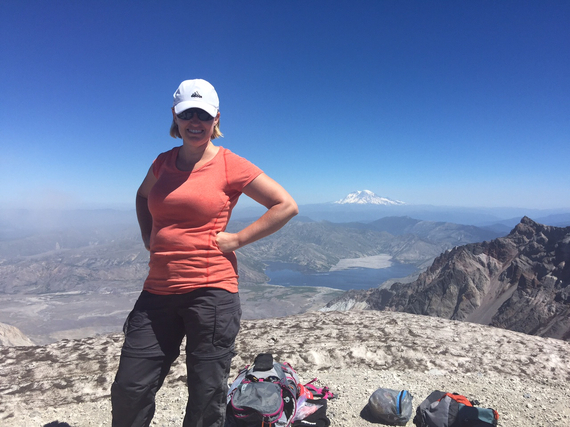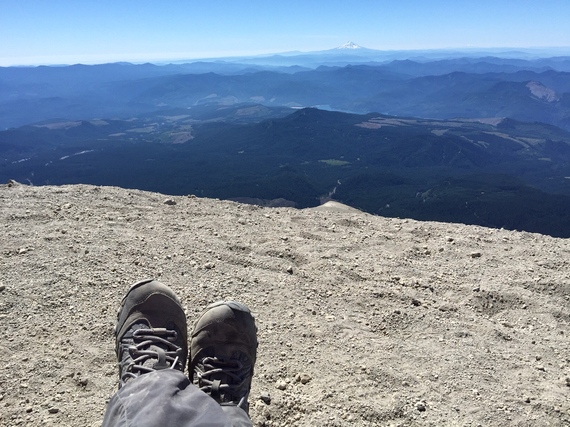Ever since my breast cancer diagnosis in October of 2011, I have lived my life differently. Whereas I used to be a very Type A, "look to the future," kind of girl, I now truly appreciate each day. I remember feeling overwhelmed with pain for weeks after my bilateral mastectomy. I could barely raise my arms, I had drains hanging from my body collecting fluid from my lymphatic system, I couldn't hug my kids, and I felt hopeless. Never in my wildest imagination could I envision getting back to even half of my former self physically, which is why my adventure on July 1st of this year means so much to me.
At the suggestion of my friend Sam, five of us set out to summit Mt. St. Helens. I never would have attempted this hike pre-cancer, but now, almost four years after my diagnosis, I feel stronger physically and mentally than at any other point in my life. I channeled my "carpe diem" mentality and accepted Sam's challenge. I was ready to see the Pacific Northwest from the top of the volcano instead of from the safety of the ground.
I will save you the play-by-play details of the hike itself, but leave you with a few things I used from my cancer experience to help me summit that mountain.
1. Create a plan. After I was diagnosed with cancer, I worked with my family and doctors to come up with a plan of action. For me, this eliminated some of the fear of the unknown. Before hiking Mt. St. Helens, I researched the hike, spoke with friends who had already made the trip and tried to prepare physically as well. I probably should have paid more attention to my friend's observation that she saw "two grown women cry" on their way up to the summit. (See #2.)
2. Follow your gut. When I felt the lump in my breast, my stomach tightened, and my gut instinct was that something was amiss in my body. I followed that instinct, even though my head kept saying, "It's probably nothing," and my cancer diagnosis came much earlier than if I had waited to get checked out by my doctor. I had similar experiences on the hike, and the one time that I didn't listen to my gut, I ended up sliding down a snowpack out of control, (think Clark Griswold on the sled in National Lampoon's Christmas Vacation), with a skinned up arm to show for it at the bottom. I should have listened to that voice that said, "Molly, this does not look like a good idea."
3. No matter how impossible the terrain, keep on moving forward. Focus on putting one foot in front of the other. It is easy to get overwhelmed when the journey seems so full of obstacles, but no ground is covered when you are standing still. During my cancer treatments, that often meant just managing to drag myself out of bed, or taking a short walk around the block with the dog. On the mountain, that meant keeping my eyes on the path, finding the most solid rocks to scale or digging in those trekking poles as the ash pulled me backwards. Just keep moving.
4. Pick small goals to get you to the top. During my chemotherapy treatments, that meant pushing through the third day post-treatment, which was my lowest point of energy, and focusing on one treatment at a time. Or concentrating on one day of surgical recovery at a time. When I was in the last stretch of the Mt. St. Helens hike, taking one step forward and sliding two steps back in the ash, heart racing, I would pick a rock ten steps ahead and tell myself, "Just make it to that rock. Then you can rest." Before I knew it, that last "rock goal" was five feet from the summit of the mountain.
5. Know when to follow a leader and know when to trust yourself. Use the path of others to help you find your way. I'm so grateful for the many women who came before me and participated in clinical trials that led to improved breast cancer treatment options. And I have found an oncologist who looks at me as a teammate in my ongoing treatment plan. Dr. A. is my fearless leader, but he takes into account my personal perspective as well. On the hike, I did not hesitate to follow the other ladies in my group as they figured out which boulders were easier to navigate or where there were loose stones. On the other hand, there were times when forging my own trail was the most efficient way to go. You know yourself better than anyone else, so trust in that.
6. Make sure to stop periodically to enjoy what you have already accomplished. When I was going through chemotherapy, I had a love-hate relationship with time. I was getting these treatments to gain more time, but I wanted the days of feeling horrible to go by as quickly as possible. I found that when I tried to celebrate mini-milestones, it helped to break up the time. A tiara at the end of chemo, a "boob day cake" after my implant swap surgery, a party to celebrate my one-year "cancerversary" -- each of those events made me realize how far I'd come and kept me going for the next challenge. In the same way, each vista on the way up Mt. St. Helens provided a more beautiful perspective on the world below. By pausing to soak in the beauty, I was reinvigorated for the next section of the challenge.
7. Take time to enjoy the view and glory at the top, but keep in mind that the path down isn't always easier. When my active treatments and surgeries were finished, the real challenge kicked in for me -- managing the fear of recurrence. Mentally, that has been one of the most difficult parts of living life post-cancer. Much as I felt like I was literally on top of the world at the top of Mt. St. Helens, coming back down was physically challenging as well. While my heart didn't race nearly as much, my muscles ached as I climbed down over boulders and slid through ash. There are always going to be challenges on the path, even when "the hard part" appears to be over.
8. Keep laughing. Cancer taught me that there is laughter to be found even in our darkest days. Having even a moment of reprieve from the fear and sadness of cancer kept me going on many an awful day. Just as I felt like I couldn't go any higher up the mountain, I would find something funny to keep me going. In many cases, that meant laughing at the sheer ridiculousness of climbing over boulder after boulder as a non-outdoorswoman. Or my similarities to a mountain goat.
9. Don't do it alone. I have never had an easy time asking for help. I had to get over that very quickly after my cancer diagnosis. I needed people to help with meals, to watch my kids while I rested on the couch exhausted, to provide a place to vent my fears and frustrations. I would never have made it through my cancer experience without the kindness of my friends and family (and sometimes even strangers!). Hiking Mt. St. Helens was made so much more rich because I shared that experience, both the glory and the challenges, with a group of amazing women. They supported me through the hard parts, and together we enjoyed the awe-inspiring view from the top.
10. Remember to breathe. Sometimes life punches you in the gut repeatedly. Each blow takes your breath away. That is out of your control. It sucks, but there's nothing you can do about it. What you can do, however, is control what you make of the experience. You can run away or you can breathe, regroup and punch back. I would normally say that I'm a lover not a fighter, but when it comes to living life, I'm ready to punch the hell out of it. And climb a mountain for good measure. Take that, cancer!

